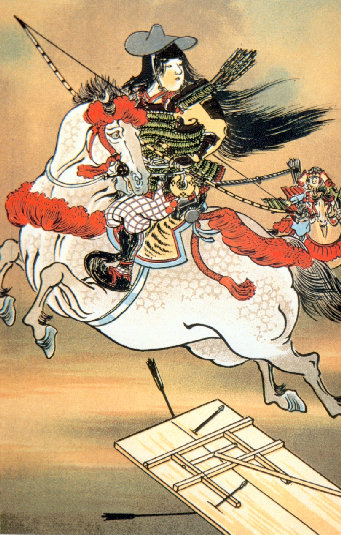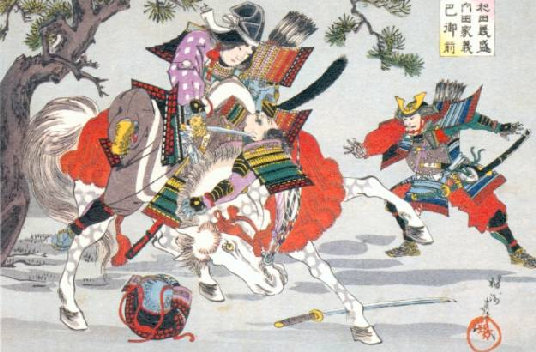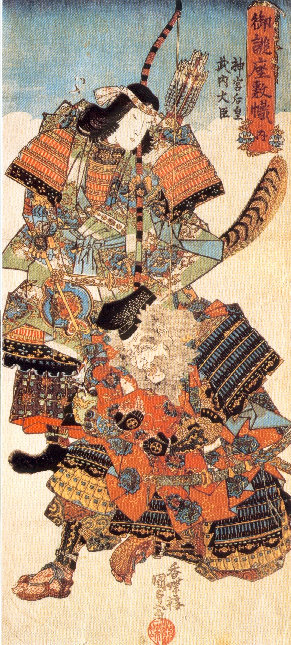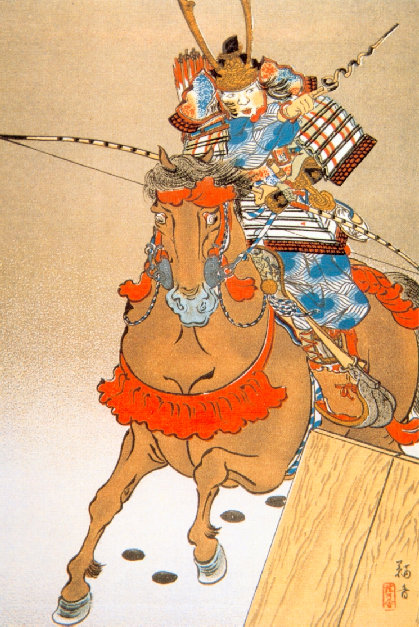Women
In samurai era Japan some women in samurai clans were active as warriors on the battlefield. The most famous are Empress Jingu, Tomoe Gozen and Hangaku. But these were the exceptions. Generally speaking women in samurai clans were responsible as the last line of defense of their homes. In times of war, a village or castle might be attacked while the main body of the army is fighting elsewhere. It was then up to the women to help defend the castle with the few men who had remained behind.
Because men are naturally physically stronger than women, many women were trained with naginata (a halberd) which gave them the advantage of distance over sword-wielding attackers. Also, archery was common for women, since they could fight off attackers at long range.

All samurai women were expected to carry a kaiken (short knife) with them at all times. In the old days, if a woman was raped the act brought shame upon her family, so a woman of a samurai family used the kaiken to kill her attacker if she could, or to kill herself (jigai).
Learning the lessons of warrior society taught women to have a strong resolve in the face of danger. Even though today it seems extreme for a woman to commit suicide to foil a rape, one must admire such determination.

The ninja made greater use of women in their warrior clans. The ninja had a secret word for female ninja, calling them ‘kunoichi’, and they were trained to use their natural femininity as a weapon to deceive stronger males. Feigning weakness, a kunoichi can lure an opponent into a false sense of security and encourage him to make fatal mistakes. The kunoichi played important roles in undercover situations, where they gained valuable information as spies, and they were equally important assets as field agents, engaging in everything from sabotage and assassination to acting as messengers and taking part in skirmishes behind enemy lines.

The unarmed skills of the ninja are excellent for use against stronger or faster opponents, so they are naturally suited for women. Any martial training is probably better than nothing, but training in the Bujinkan is far more effective for learning the type of techniques that really do not require being stronger or faster than your opponent. Not only are women able to learn realistic skills that enable them to effectively defend themselves against muggers, rapists, and murderers, but the empowering aspect of those new skills lend a heightened confidence that enables women to succeed against the challenges of life and achieve many goals.
Children
Note: There are currently no children’s classes at the Kocho Dojo.
In the old days, samurai and ninja children began their training at the age of 5 or 6. For them, the training in warrior arts was their formal education, and they were learning the profession that they were born to, that of professional warriors. Their education needed to start early so that they would be prepared to go to war as early as in their teens. A warrior ‘s education was seen as very valuable in those days, and it produced men and women of very high caliber, people who could accomplish things, the kind of people who governed the whole country of Japan.
Every parent wants the best things for their children and no one wants children to have to endure dangerous situations. Unfortunately there are all too many stories in the news of bad things happening to children, and there are many more stories that never make it to the evening news. Schools are more dangerous than ever before, not to mention the possibilities outside of school. When I was in high school I was attacked twice by other students with switch blade knives, now children are bringing guns to school, and using them…

Parents can not be at their children’s sides at all times to protect them, so the best thing that a parent can do for their children is to give them the skills to defend themselves. But what style of martial art should a child be taught?
Martial arts like Karate, Taekwondo, and Judo are on every street corner in major cities like greater Los Angeles, but these studios tend to emphasize sporting competitions. Parents are generally more comfortable with a sporting activity for their children, since it is a similar setting to other socially acceptable activities like little league baseball. But learning to defend oneself should not be considered an after school activity on par with a sport. Even though boxing might be used to handle some situations, boxing is not sufficient to handle dirty fighting or weapons attacks. The same is true of simple martial arts like Karate and Taekwondo.
At the Kocho Dojo the youth students are not taught sports but rather concentrate upon learning the techniques that will help them to survive in realistic self-defense situations where there are no rules. Unlike other martial arts that are limited to combinations of punching, kicking and blocking, students at the Kocho Dojo learn to use a wider range of skills to help them overcome bigger, stronger, and meaner opponents.
These techniques include manipulating pressure points on the body, joint locks and grappling, as well as tripping and throwing to the ground, where an attacker can be restrained with the effective restraining skills of the warriors of old. This overall method is more effective than the approach of other limited styles, which teach only to out-punch and out-kick the opponent. Students of the Kocho Dojo learn to control an attacker and not risk getting injured in a prolonged slug-out.
Our training also includes training with weapons such as knives and sticks, because weapons such as these are too common to be ignored, even in schools. It is important to know how to use weapons in order to be able to defend against attacks with weapons.
Most children have to cope with a lot of fear as they are learning the lessons of life. Tremendous peer pressure and the fear of intimidating bullies can have a damaging effect upon children and influence them into making very bad choices. In addition, if children do not have the skills to help themselves, they may unwittingly be adopting a defeatist mentality and simply accept being victims and seeing themselves as helpless and worthless. Being helpless in the face of violence can leave hidden scars that will damage a person for the rest of their life.
Even if a child never has to defend him or herself even once in their life, warrior training will be invaluable in giving them the confidence to achieve anything in life. Having power in the most difficult of life’s situations, that of violent struggle, will give a person the confident ‘can do’ attitude that will help in every aspect of life, from getting good grades in school, to being able to have healthy relationships with others, and to being capable of successfully achieving career goals.
Training in warrior arts is not an after school sport but rather an investment in the future of your children. Give them the power to handle the challenges they will face and help them to achieve everything necessary for a fulfilled and happy life. Train them to be warriors.
